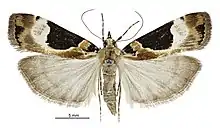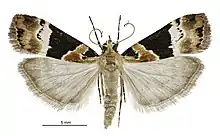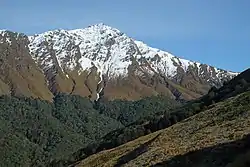Eudonia aspidota
Eudonia aspidota is a moth in the family Crambidae. It is found in New Zealand and can be found in the North, South and Stewart Islands. The species inhabits native forest and its larvae lives on mosses.
| Eudonia aspidota | |
|---|---|
 | |
| Female | |
 | |
| Male | |
| Scientific classification | |
| Domain: | Eukaryota |
| Kingdom: | Animalia |
| Phylum: | Arthropoda |
| Class: | Insecta |
| Order: | Lepidoptera |
| Family: | Crambidae |
| Genus: | Eudonia |
| Species: | E. aspidota |
| Binomial name | |
| Eudonia aspidota (Meyrick, 1884) | |
| Synonyms | |
| |
Taxonomy
This species was first described by Edward Meyrick in 1884 and named Xeroscopa aspidota.[1][2] Meyrick added further detail when he described the species in 1885.[3] In 1913 Meyrick placed the species within the genus Scoparia.[4] George Hudson described and illustrated this species in the book The butterflies and moths of New Zealand.[5] In 1988 John S. Dugdale placed this species in the genus Eudonia.[6] The male lectotype, collected at Ben Lomond by Meyrick, is held at the Natural History Museum, London.[6]
Description
.jpg.webp)
The wingspan is 22–26 mm. The forewings are light ochreous, sometimes mixed with reddish-ochreous. There is a black white-margined triangular spot on the costa. The hindwings are pale grey with a darker grey post medial and hind marginal line.[3]
Although the wing markings of this species attract attention, they also imitate bird droppings.[5] This mimicry offers protection to E. aspidota when it is not in flight.[5]
Distribution

E. aspidota is endemic in New Zealand.[7] Meyrick stated it could be found in Wellington, Castle Hill, Mount Hutt, Dunedin and Lake Wakatipu.[3] George Hudson added to the localities where E. aspidota could be found and included Raurimu, Waimarino, Buller River, Invercargill and Stewart Island.[5] Hudson was of the opinion that the species was probably distributed throughout New Zealand.[5]
Behaviour
Adults of E. aspidota are normally present during December and January.[3][10] This species is attracted to light.[5]
References
- Meyrick, Edward (1884). "Descriptions of New Zealand Microlepidoptera. IV. Scopariadae". New Zealand Journal of Science. 2: 235–237 – via Biodiversity Heritage Library.
- Gordon, Dennis P., ed. (2010). New Zealand inventory of biodiversity: Kingdom animalia : chaetognatha, ecdysozoa, ichnofossils. Vol. 2. p. 458. ISBN 978-1-877257-93-3. OCLC 973607714. OL 25288394M. Wikidata Q45922947.
- Meyrick, E. (1884). "Descriptions of New Zealand Micro-Lepidoptera". Transactions and Proceedings of the New Zealand Institute. 17: 68–149 – via Biodiversity Heritage Library.
- Meyrick, E. (1913). "A revision of New Zealand Pyralidina". Transactions and Proceedings of the New Zealand Institute. 45: 30–51 – via Biodiversity Heritage Library.
- Hudson, G. V. (1928). The Butterflies and Moths of New Zealand. Wellington: Ferguson & Osborn Ltd. pp. 201–202.
- John Stewart Dugdale (23 September 1988). "Lepidoptera - annotated catalogue, and keys to family-group taxa". Fauna of New Zealand. Department of Scientific and Industrial Research. 14: 160. doi:10.7931/J2/FNZ.14. ISSN 0111-5383. Wikidata Q45083134.
- "Eudonia aspidota (Meyrick, 1884)". www.nzor.org.nz. Landcare Research New Zealand Ltd. Retrieved 17 December 2017.
- Patrick, Hamish J.H.; Bowie, Mike H.; Fox, Barry W.; Patrick, Brian H. (2011). "The moths of Quail Island (Ōtamahua): a faunal comparison of an island under restoration with other sites on Banks Peninsula" (PDF). New Zealand Natural Sciences. 36: 57–72. Archived from the original (PDF) on 2016-03-03. Retrieved 2017-12-17.
- Robert J. B. Hoare (2020), The Moths of Mt Te Aroha (PDF), pp. 1–11, Wikidata Q113345596, archived from the original (PDF) on 7 March 2022
- Brian H. Patrick (1991). Insects of the Dansey Ecological District (PDF). pp. 1–25. ISBN 0-478-01285-3. ISSN 0113-3713. Wikidata Q110318301. Archived from the original (PDF) on 30 December 2021.
{{cite book}}:|journal=ignored (help)